Abstract
The State of Michigan has a long history of research into human exposure to environmental contaminants through consumption of recreationally caught fish. A large cohort of Lake Michigan residents who eat fish (fish-eaters) and those who do not eat fish (nonfish-eaters) established in 1980 served as the basis for the congener-specific polychlorinated biphenyl (PCB) exposure evaluation reported here. In this paper we present the serum PCB congener profile for a subset of this cohort who were over 50 years of age. Serum samples were collected in 1993-1995 and were evaluated by a dual column capillary column gas chromatography procedure capable of detecting over 90 PCB congeners. This evaluation demonstrated significant PCB exposure in the fish-eaters (mean serum PCB of 14.26 ppb; n = 101). This elevated exposure allowed the establishment of a detailed profile of the PCB congeners found in humans exposed by this route. Twenty-two congeners of varying concentrations were the most prevalent and constituted over 95% of the total PCB present in most subjects. Four congeners, 138/163 (2,2',3,4,4',5-PCB/2,3,3',4', 5,6-PCB), 180 (2,2',3,4,4',5,5'-PCB), and 153 (2,2',4,4',5,5'-PCB), accounted for 55-64% of the total PCB load. Other congeners, some of toxicologic significance, were also detected by this analytical protocol. Nonfish-eaters had lower total serum PCB levels (mean = 4. 56; n = 78), but the same general pattern of PCB congeners was present. It was demonstrated that careful selection of a subset of prevalent PCB congeners could provide a cost-effective assessment of exposure without losing critical scientific information.
Full text
PDF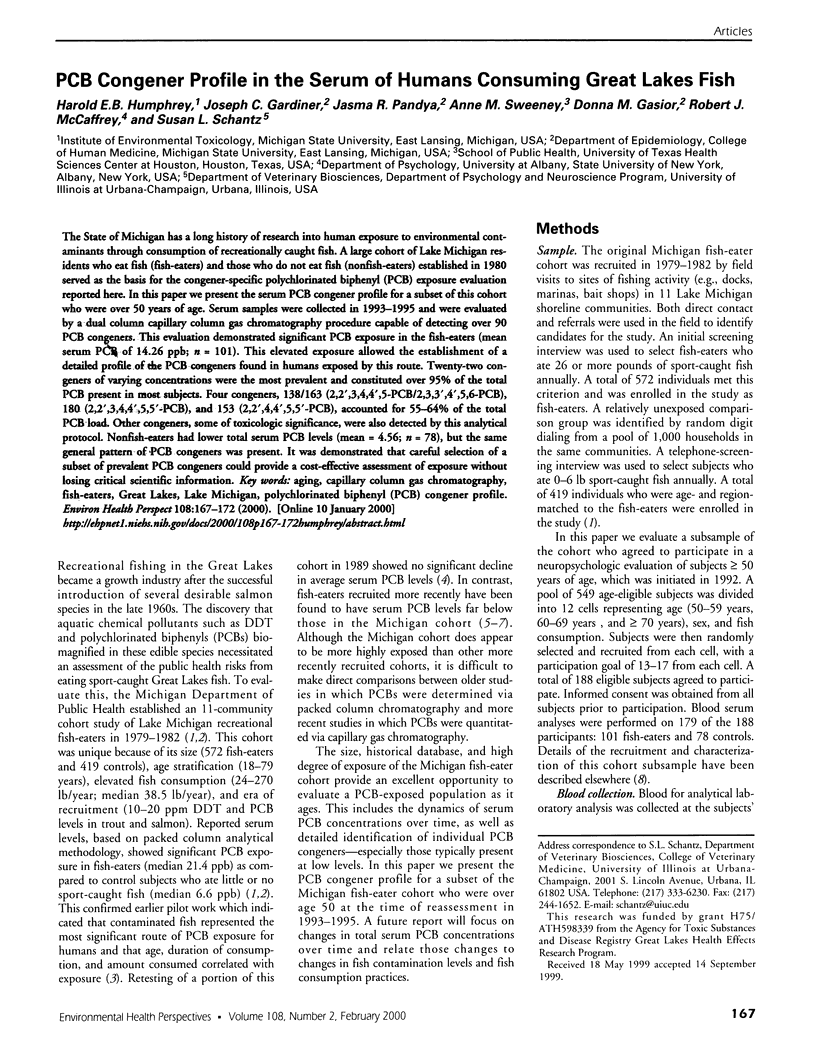
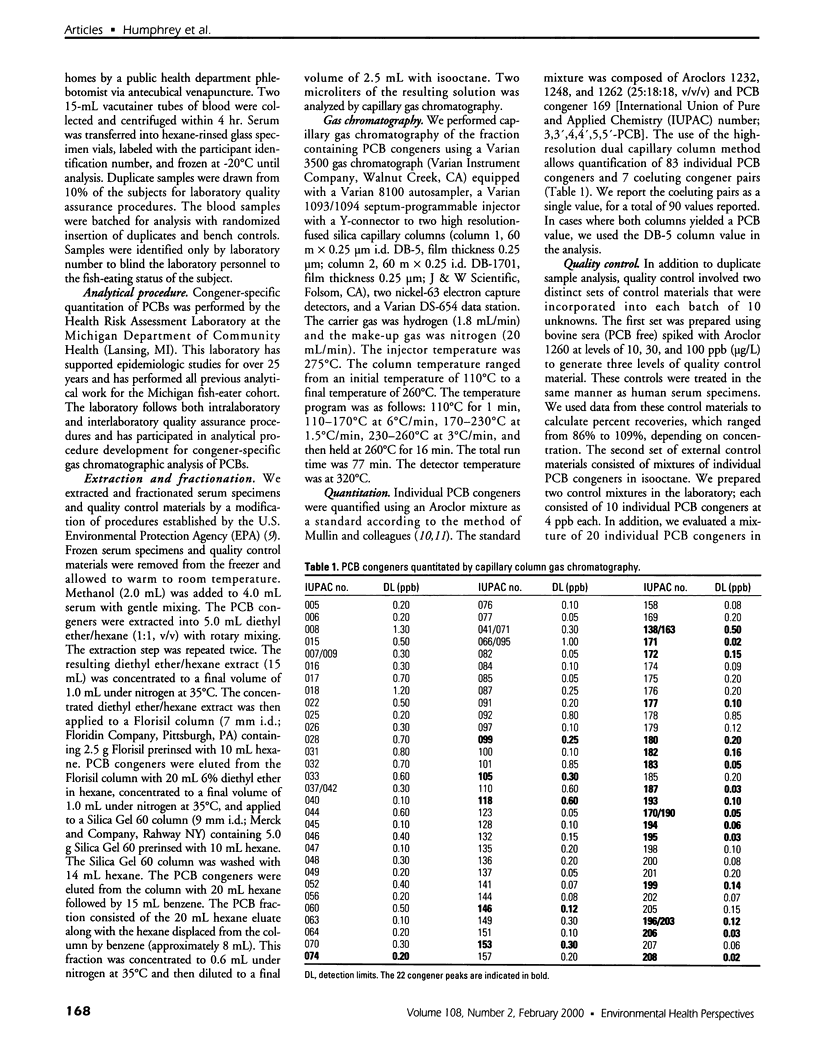
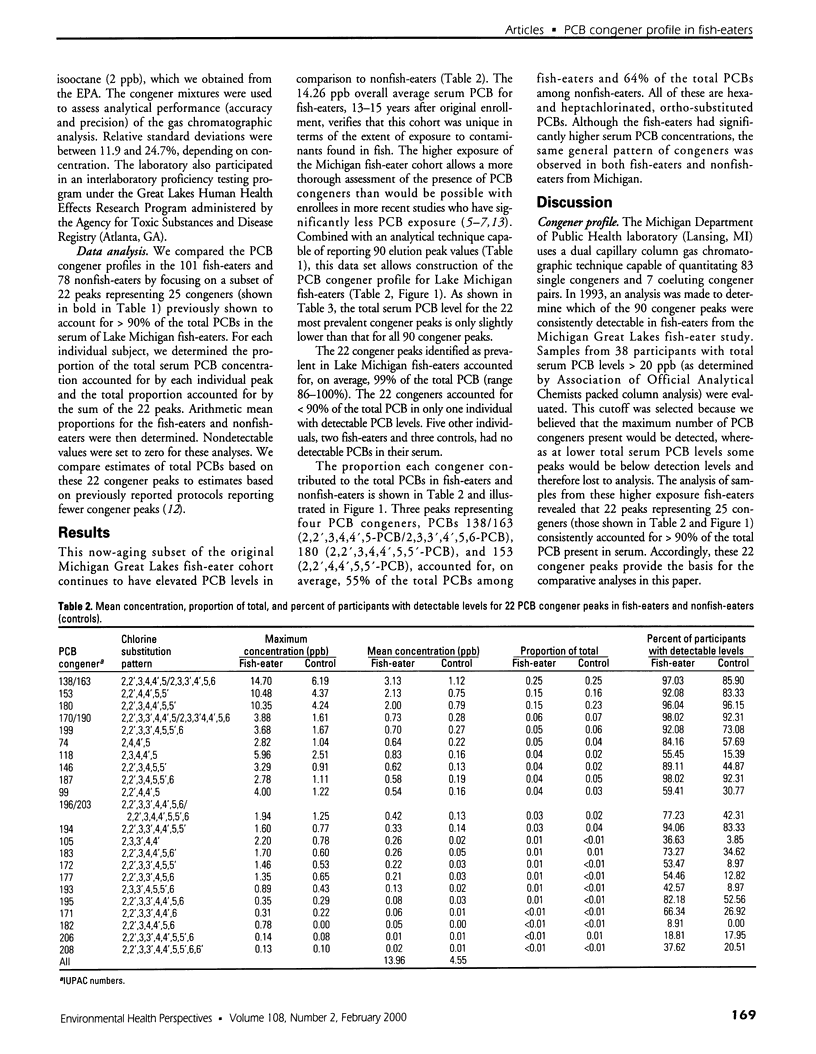
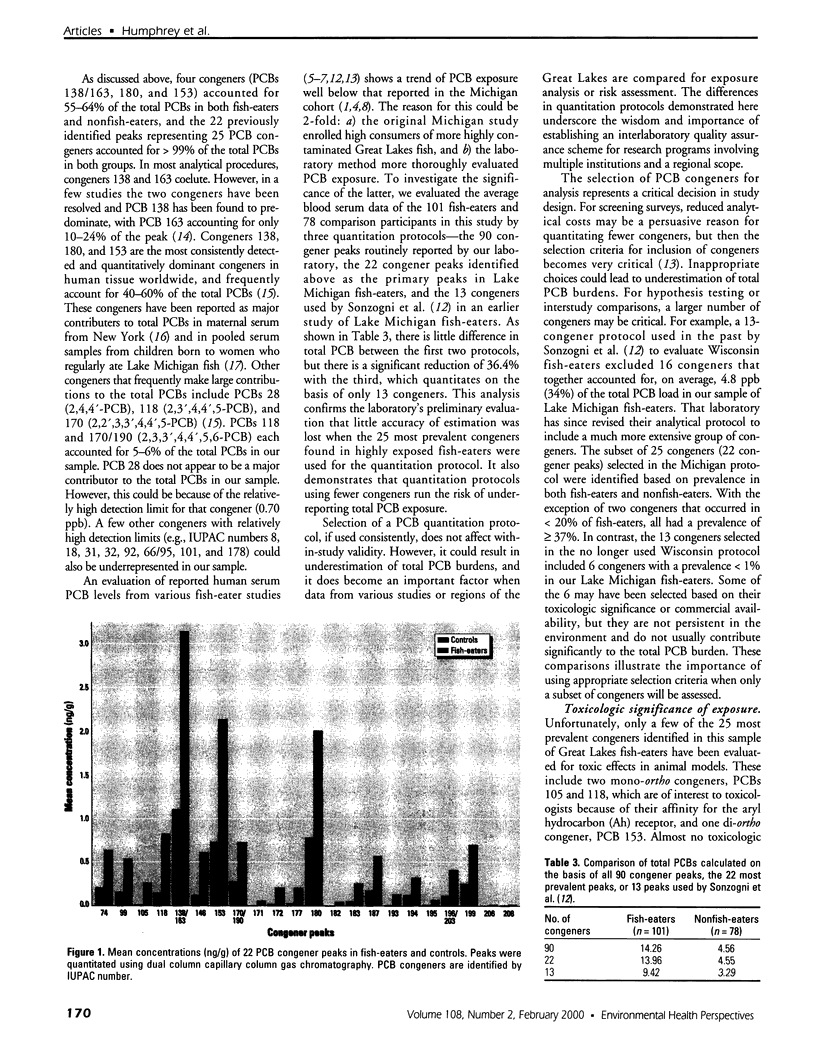

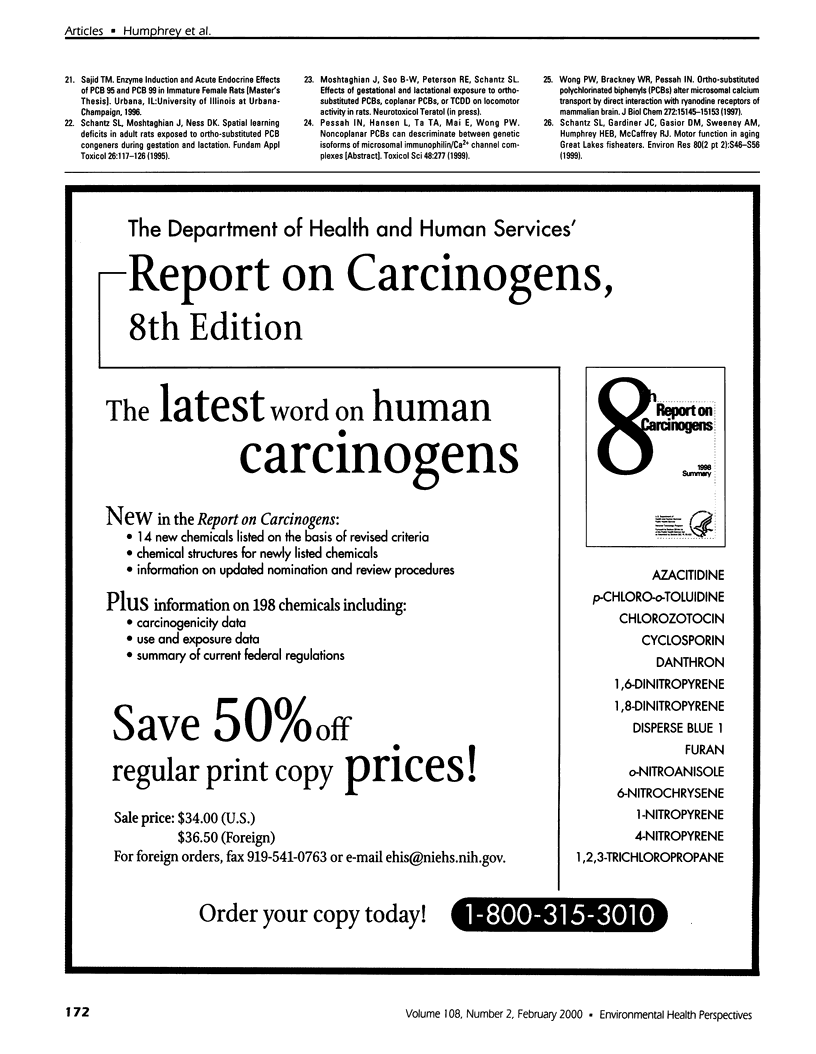
Images in this article
Selected References
These references are in PubMed. This may not be the complete list of references from this article.
- Anderson H. A., Falk C., Hanrahan L., Olson J., Burse V. W., Needham L., Paschal D., Patterson D., Jr, Hill R. H., Jr Profiles of Great Lakes critical pollutants: a sentinel analysis of human blood and urine. The Great Lakes Consortium. Environ Health Perspect. 1998 May;106(5):279–289. doi: 10.1289/ehp.98106279. [DOI] [PMC free article] [PubMed] [Google Scholar]
- Bush B., Snow J., Koblintz R. Polychlorobiphenyl (PCB) congeners, p,p'-DDE, and hexachlorobenzene in maternal and fetal cord blood from mothers in Upstate New York. Arch Environ Contam Toxicol. 1984 Sep;13(5):517–527. doi: 10.1007/BF01056331. [DOI] [PubMed] [Google Scholar]
- DeRosa C. T., Wilbur S., Holler J., Richter P., Stevens Y. W. Health evaluation of 1,4-dioxane. Toxicol Ind Health. 1996 Jan-Feb;12(1):1–43. doi: 10.1177/074823379601200101. [DOI] [PubMed] [Google Scholar]
- DeVoto E., Fiore B. J., Millikan R., Anderson H. A., Sheldon L., Sonzogni W. C., Longnecker M. P. Correlations among human blood levels of specific PCB congeners and implications for epidemiologic studies. Am J Ind Med. 1997 Dec;32(6):606–613. doi: 10.1002/(sici)1097-0274(199712)32:6<606::aid-ajim6>3.0.co;2-n. [DOI] [PubMed] [Google Scholar]
- Fiore B. J., Anderson H. A., Hanrahan L. P., Olson L. J., Sonzogni W. C. Sport fish consumption and body burden levels of chlorinated hydrocarbons: a study of Wisconsin anglers. Arch Environ Health. 1989 Mar-Apr;44(2):82–88. doi: 10.1080/00039896.1989.9934380. [DOI] [PubMed] [Google Scholar]
- Gerstenberger S. L., Tavris D. R., Hansen L. K., Pratt-Shelley J., Dellinger J. A. Concentrations of blood and hair mercury and serum PCBs in an Ojibwa population that consumes Great Lakes region fish. J Toxicol Clin Toxicol. 1997;35(4):377–386. doi: 10.3109/15563659709043370. [DOI] [PubMed] [Google Scholar]
- Hansen L. G. Stepping backward to improve assessment of PCB congener toxicities. Environ Health Perspect. 1998 Feb;106 (Suppl 1):171–189. doi: 10.1289/ehp.98106s1171. [DOI] [PMC free article] [PubMed] [Google Scholar]
- Hovinga M. E., Sowers M., Humphrey H. E. Historical changes in serum PCB and DDT levels in an environmentally-exposed cohort. Arch Environ Contam Toxicol. 1992 May;22(4):362–366. doi: 10.1007/BF00212554. [DOI] [PubMed] [Google Scholar]
- Jacobson J. L., Humphrey H. E., Jacobson S. W., Schantz S. L., Mullin M. D., Welch R. Determinants of polychlorinated biphenyls (PCBs), polybrominated biphenyls (PBBs), and dichlorodiphenyl trichloroethane (DDT) levels in the sera of young children. Am J Public Health. 1989 Oct;79(10):1401–1404. doi: 10.2105/ajph.79.10.1401. [DOI] [PMC free article] [PubMed] [Google Scholar]
- Li M. H., Zhao Y. D., Hansen L. G. Multiple dose toxicokinetic influence on the estrogenicity of 2,2',4,4',5,5'-hexachlorobiphenyl. Bull Environ Contam Toxicol. 1994 Oct;53(4):583–590. doi: 10.1007/BF00199030. [DOI] [PubMed] [Google Scholar]
- Ness D. K., Schantz S. L., Moshtaghian J., Hansen L. G. Effects of perinatal exposure to specific PCB congeners on thyroid hormone concentrations and thyroid histology in the rat. Toxicol Lett. 1993 Jun;68(3):311–323. doi: 10.1016/0378-4274(93)90023-q. [DOI] [PubMed] [Google Scholar]
- Schantz S. L., Gardiner J. C., Gasior D. M., Sweeney A. M., Humphrey H. E., McCaffrey R. J. Motor function in aging Great Lakes fisheaters. Environ Res. 1999 Feb;80(2 Pt 2):S46–S56. doi: 10.1006/enrs.1998.3904. [DOI] [PubMed] [Google Scholar]
- Schantz S. L., Moshtaghian J., Ness D. K. Spatial learning deficits in adult rats exposed to ortho-substituted PCB congeners during gestation and lactation. Fundam Appl Toxicol. 1995 Jun;26(1):117–126. doi: 10.1006/faat.1995.1081. [DOI] [PubMed] [Google Scholar]
- Schantz S. L., Sweeney A. M., Gardiner J. C., Humphrey H. E., McCaffrey R. J., Gasior D. M., Srikanth K. R., Budd M. L. Neuropsychological assessment of an aging population of Great Lakes fisheaters. Toxicol Ind Health. 1996 May-Aug;12(3-4):403–417. doi: 10.1177/074823379601200312. [DOI] [PubMed] [Google Scholar]
- Sonzogni W., Maack L., Gibson T., Degenhardt D., Anderson H., Fiore B. Polychlorinated biphenyl congeners in blood of Wisconsin sport fish consumers. Arch Environ Contam Toxicol. 1991 Jan;20(1):56–60. doi: 10.1007/BF01065328. [DOI] [PubMed] [Google Scholar]
- Wong P. W., Brackney W. R., Pessah I. N. Ortho-substituted polychlorinated biphenyls alter microsomal calcium transport by direct interaction with ryanodine receptors of mammalian brain. J Biol Chem. 1997 Jun 13;272(24):15145–15153. doi: 10.1074/jbc.272.24.15145. [DOI] [PubMed] [Google Scholar]



